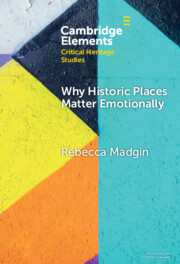Refine search
Actions for selected content:
664 results
5 - The Franco-Prussian War
- from Part II - The Post-Napoleonic Nineteenth Century
-
- Book:
- Crises, War, and Diplomacy
- Published online:
- 07 November 2025
- Print publication:
- 20 November 2025, pp 85-108
-
- Chapter
- Export citation
17 - Looking Back and Looking Ahead: What about Emotion, Culture, Artificial Intelligence, and Intuition?
- from Part III - Applications, Examples, and Selected Topics
-
- Book:
- Making Decisions: Analytics, Cognition, and Application
- Published online:
- 23 October 2025
- Print publication:
- 06 November 2025, pp 247-252
-
- Chapter
- Export citation

Why Historic Places Matter Emotionally
- Responses - Attachments - Communities
-
- Published online:
- 22 October 2025
- Print publication:
- 13 November 2025
-
- Element
-
- You have access
- Open access
- HTML
- Export citation
The Widowers’ Two Plights: Toward a Cultural History of Bereaved Husbands
-
- Journal:
- Comparative Studies in Society and History , First View
- Published online by Cambridge University Press:
- 17 October 2025, pp. 1-25
-
- Article
-
- You have access
- Open access
- HTML
- Export citation
Chapter 15 - Language and Emotion Concepts in the Predictive Brain
- from Section III - Emotion Perception and Elicitation
-
-
- Book:
- The Cambridge Handbook of Human Affective Neuroscience
- Published online:
- 16 September 2025
- Print publication:
- 02 October 2025, pp 306-322
-
- Chapter
- Export citation
Chapter 30 - Emotion and Affective Disorders
- from Section VII - Individual Differences
-
-
- Book:
- The Cambridge Handbook of Human Affective Neuroscience
- Published online:
- 16 September 2025
- Print publication:
- 02 October 2025, pp 604-617
-
- Chapter
- Export citation
Chapter 26 - Neural Evidence for Cultural Variation in Emotion
- from Section VI - Social Emotions
-
-
- Book:
- The Cambridge Handbook of Human Affective Neuroscience
- Published online:
- 16 September 2025
- Print publication:
- 02 October 2025, pp 523-543
-
- Chapter
- Export citation
Chapter 4 - Peripheral Physiological Measures of Emotion
- from Section II - Measuring Emotional Processes
-
-
- Book:
- The Cambridge Handbook of Human Affective Neuroscience
- Published online:
- 16 September 2025
- Print publication:
- 02 October 2025, pp 72-100
-
- Chapter
- Export citation
Chapter 19 - Affective Biases in Attention, Cognitive Control, and Awareness
- from Section V - Cognition–Emotion Interactions
-
-
- Book:
- The Cambridge Handbook of Human Affective Neuroscience
- Published online:
- 16 September 2025
- Print publication:
- 02 October 2025, pp 385-407
-
- Chapter
- Export citation
Chapter 1 - Theories of Emotion for Human Affective Neuroscience
- from Section I - Theoretical Models of Emotion
-
-
- Book:
- The Cambridge Handbook of Human Affective Neuroscience
- Published online:
- 16 September 2025
- Print publication:
- 02 October 2025, pp 7-32
-
- Chapter
- Export citation
26 - Ethnography, Experience, and Coming of Age at the Margins
- from Part V - Postcolonial and Political–Economic Interventions
-
-
- Book:
- The Cambridge Handbook of Psychological Anthropology
- Published online:
- 22 October 2025
- Print publication:
- 25 September 2025, pp 629-648
-
- Chapter
- Export citation
9 - Visual Psychological Anthropology
- from Part II - Methodological Innovations
-
-
- Book:
- The Cambridge Handbook of Psychological Anthropology
- Published online:
- 22 October 2025
- Print publication:
- 25 September 2025, pp 222-250
-
- Chapter
- Export citation
16 - Steps toward an Interdisciplinary Anthropology of Mind and Emotion
- from Part IV - Body, Emotion, Self, and Experience
-
-
- Book:
- The Cambridge Handbook of Psychological Anthropology
- Published online:
- 22 October 2025
- Print publication:
- 25 September 2025, pp 389-411
-
- Chapter
- Export citation
2 - Cognitive Foundations and Cultural Models
- from Part I - Theoretical Foundations
-
-
- Book:
- The Cambridge Handbook of Psychological Anthropology
- Published online:
- 22 October 2025
- Print publication:
- 25 September 2025, pp 37-61
-
- Chapter
- Export citation
15 - Dying and an Afterlife
- from Part III - Lifespan Development in Diverse Sociocultural Contexts
-
-
- Book:
- The Cambridge Handbook of Psychological Anthropology
- Published online:
- 22 October 2025
- Print publication:
- 25 September 2025, pp 367-386
-
- Chapter
- Export citation
19 - Emotion and Affect
- from Part IV - Body, Emotion, Self, and Experience
-
-
- Book:
- The Cambridge Handbook of Psychological Anthropology
- Published online:
- 22 October 2025
- Print publication:
- 25 September 2025, pp 460-482
-
- Chapter
- Export citation
Chapter 6 - Resisting the Blows of Fortune
-
-
- Book:
- Cicero's <i>Tusculan Disputations</i>
- Published online:
- 11 September 2025
- Print publication:
- 18 September 2025, pp 102-120
-
- Chapter
- Export citation

Cicero's Tusculan Disputations
-
- Published online:
- 11 September 2025
- Print publication:
- 18 September 2025
10 - Memetic Discourse on Social Media Platforms
-
- Book:
- The Language of Memes
- Published online:
- 12 September 2025
- Print publication:
- 11 September 2025, pp 171-201
-
- Chapter
- Export citation
‘your poore distressed suppliant’: ‘Madness’, Emotion and the Archive in Early Modern England
-
- Journal:
- Transactions of the Royal Historical Society , First View
- Published online by Cambridge University Press:
- 02 September 2025, pp. 1-24
-
- Article
-
- You have access
- Open access
- HTML
- Export citation
